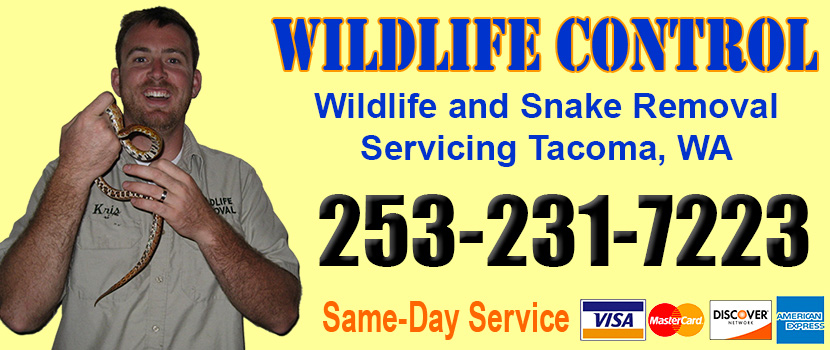
Welcome to tacomasnakes.com! I am David, a snake enthusiast living in Tacoma, WA. Many people don't know that Tacoma is in fact full of snakes! You just need to know where to find them - they can often be shy and elusive. Some Washington snake species are more common outside of the city limits, in different parts of Pierce County WA, but many types of snakes are indeed common in the more urban parts of Tacoma. This guide is meant to help educate you about the beautiful snakes of Tacoma, and to help you identify the most common snakes of Tacoma, as well as the venomous snakes of Tacoma that you should learn to recognize and avoid. If you want more detail, click here for my complete list of ALL snake species in Tacoma. Remember the following:
- Most snakes of Tacoma are harmless and don't want to encounter you
- Venomous snakes exist but are uncommon in Tacoma, Washington
- Snakes eat rats and mice and are a valuable part of the Washington ecosystem
- Never kill a snake - if you leave a snake alone, it will leave you alone.
Common Snake Species in Tacoma
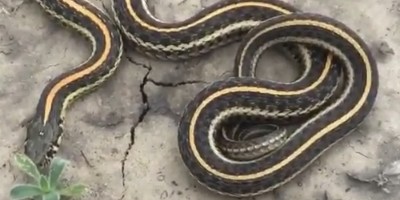 Plains Garter Snake:
A plains garter snake can be identified by its dark brown to dark green coloring with yellow or orange stripes. Their sides may also contain some red pigmentation, and there are usually black spots in their ventral scales. The males are larger than the females, with a longer tail that accounts for about 20% to 28% of their total body length. These snakes are usually 15 to 28 inches long, and they are commonly found in meadows and grasslands near bodies of water such as ponds, streams, and marshes. Their food preference is very wide, and they have been observed eating frogs, salamanders, fish, birds, rodents, leeches, mosquito fishes, and meadowlarks. They usually hunt by following an olfactory trail and then striking and grabbing their prey once they have caught up with them.
Plains Garter Snake:
A plains garter snake can be identified by its dark brown to dark green coloring with yellow or orange stripes. Their sides may also contain some red pigmentation, and there are usually black spots in their ventral scales. The males are larger than the females, with a longer tail that accounts for about 20% to 28% of their total body length. These snakes are usually 15 to 28 inches long, and they are commonly found in meadows and grasslands near bodies of water such as ponds, streams, and marshes. Their food preference is very wide, and they have been observed eating frogs, salamanders, fish, birds, rodents, leeches, mosquito fishes, and meadowlarks. They usually hunt by following an olfactory trail and then striking and grabbing their prey once they have caught up with them.
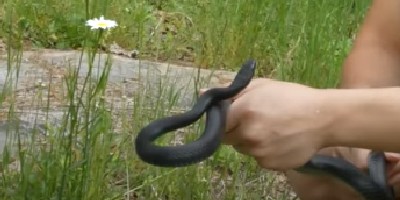 Racer Snake:
Racer snakes usually have coloration in shades of blue, blue-green, gray, and sometimes even brown. They might also occasionally have yellow bellies. These snakes are a part of the Colubridae family. Racer snakes tend to be slimmer and have longer tails than other snakes. They have large eyes and have oddly smooth scales. These guys can grow up to 1.8 meters long and can move really fast, slithering at around 5.6 kilometers per hour. One unique attribute this snake has is that if they are cornered by something they perceive to be a threat, they begin to vibrate and shake their tail.
Racer Snake:
Racer snakes usually have coloration in shades of blue, blue-green, gray, and sometimes even brown. They might also occasionally have yellow bellies. These snakes are a part of the Colubridae family. Racer snakes tend to be slimmer and have longer tails than other snakes. They have large eyes and have oddly smooth scales. These guys can grow up to 1.8 meters long and can move really fast, slithering at around 5.6 kilometers per hour. One unique attribute this snake has is that if they are cornered by something they perceive to be a threat, they begin to vibrate and shake their tail.
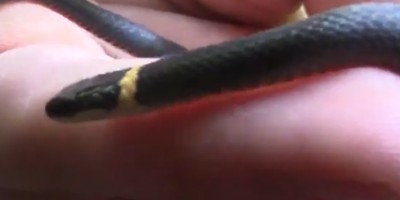 Ring-necked Snake:
Ring-necked snakes have a distinct type of coloration that makes them easy to identify, their scales are ventral in color which is usually yellow and slowly gradates to red. Not only that but they also have black spots all around their body. Their coloration is also how they get their name, for they have a yellow line around their necks that form a ring. Though in other parts of the country like in Idaho, these snakes lack the ring around their neck. These snakes also tend to be very small reaching the sizes of about 50cm, but they can reach up to 75cm from time to time.
Ring-necked Snake:
Ring-necked snakes have a distinct type of coloration that makes them easy to identify, their scales are ventral in color which is usually yellow and slowly gradates to red. Not only that but they also have black spots all around their body. Their coloration is also how they get their name, for they have a yellow line around their necks that form a ring. Though in other parts of the country like in Idaho, these snakes lack the ring around their neck. These snakes also tend to be very small reaching the sizes of about 50cm, but they can reach up to 75cm from time to time.
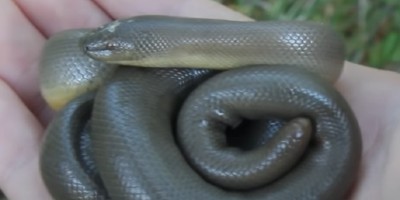 Rubber Boa:
Rubber boas are usually colored with different shades of brown and have a light yellow belly. When they are young however they start off as pink and as they age they begin to develop their darker shades. These snakes tend to select prey that are easy targets, examples of which are the young of other underground animals. Because of this, most rubber boas have scratches on their tails as a result of the other animals protecting their young. Rubber boas are also known to be most active during the night. These guys are small and stout, they also have smooth scales. They can grow from 21 to 26 inches.
Rubber Boa:
Rubber boas are usually colored with different shades of brown and have a light yellow belly. When they are young however they start off as pink and as they age they begin to develop their darker shades. These snakes tend to select prey that are easy targets, examples of which are the young of other underground animals. Because of this, most rubber boas have scratches on their tails as a result of the other animals protecting their young. Rubber boas are also known to be most active during the night. These guys are small and stout, they also have smooth scales. They can grow from 21 to 26 inches.
Venomous Snake Species in Tacoma
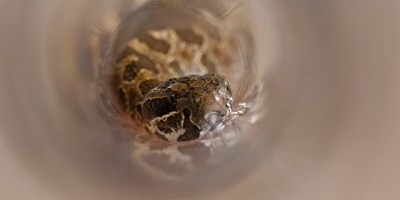 Massasauga Rattlesnake:
The massasauga rattlesnake has a distinct row of large black/dark brown hourglass-shaped markings along its back, and it also has three rows of small dark spots on its sides. It is usually gray in color, though around its head area it has a dark line that is connected to its eyes and the back of its jaw. Sometimes, however, adults become fully black in color. This type of rattlesnake can also be distinguished through the large scales on the crown of its head. This snake can range from 18-40 inches long, and averages at 27.5 inches. The name “massasauga” means “great river-mouth”, which is a reference to how this snake prefers wet habitats.
Massasauga Rattlesnake:
The massasauga rattlesnake has a distinct row of large black/dark brown hourglass-shaped markings along its back, and it also has three rows of small dark spots on its sides. It is usually gray in color, though around its head area it has a dark line that is connected to its eyes and the back of its jaw. Sometimes, however, adults become fully black in color. This type of rattlesnake can also be distinguished through the large scales on the crown of its head. This snake can range from 18-40 inches long, and averages at 27.5 inches. The name “massasauga” means “great river-mouth”, which is a reference to how this snake prefers wet habitats.
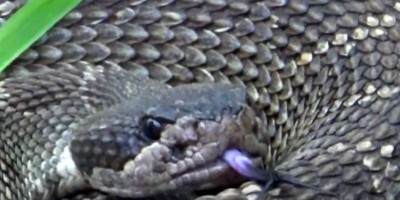 Western Rattlesnake:
The western rattlesnake can easily be distinguished due to its triangularly shaped head, and obviously because of the rattle at the end of their tails. Their rattles are actually made out of their old skin interlocked to one another. Young rattlesnake rattles are called “buttons”. It is easy for rattlesnakes to accidentally break off their rattles, so looking for one on a snake isn’t a reliable method to identify them. These snakes can reach up to 6 feet in length, but their sizes can vary. These snakes can also be located in both rural and urban areas. They are found in many places, but they do have a tendency to avoid arid locations.
Western Rattlesnake:
The western rattlesnake can easily be distinguished due to its triangularly shaped head, and obviously because of the rattle at the end of their tails. Their rattles are actually made out of their old skin interlocked to one another. Young rattlesnake rattles are called “buttons”. It is easy for rattlesnakes to accidentally break off their rattles, so looking for one on a snake isn’t a reliable method to identify them. These snakes can reach up to 6 feet in length, but their sizes can vary. These snakes can also be located in both rural and urban areas. They are found in many places, but they do have a tendency to avoid arid locations.
If you're unsure, you can email me a photo of the snake at info@tacomasnakes.com and I will email you back with the snake's species. If you found a snake skin, read my Found a Skin? page, and you can email me a photo of the skin, and I'll identify the snake for you. If you need professional Tacoma snake removal help, click my Get Help page, or see the below website sponsor I found, who provides that service.
Remember, the term is not poisonous snakes of Tacoma, it's venomous snakes of Tacoma. Poison is generally something you eat, and venom is injected into you. That said, dangerous snakes are very rare in Tacoma. The few venomous snakes of Pierce County are rarely seen. But they are commonly misidentified, so learn about all the snake species of Tacoma in order to correctly identify them. These snakes are usually also found in the surrounding towns of Puyallup, Lakewood, Gig Harbor, Bonney Lake, Spanaway, University Place, Sumner, Graham, Steilacoom, Orting, Fife, Eatonville, South Hill, Buckley, Parkland, Fircrest, DuPont, Edgewood, Frederickson, Roy, Ruston, Fox Island, Carbonado, Wilkeson, South Prairie, Hom, Kapowsin, Greenwater, Ashford, Elbe, Purdy, Elk Plain, Summi, Artondale, Midland, and the surrounding areas.
Read our article about:
Where Do Snakes Go When It Rains?
tacomasnakes.com domain and hosting costs made possible by the generous support of this sponsor:
